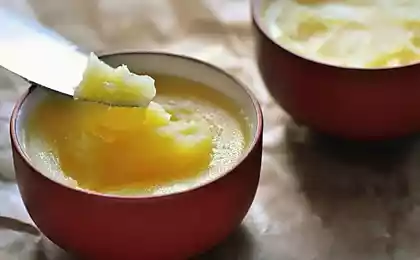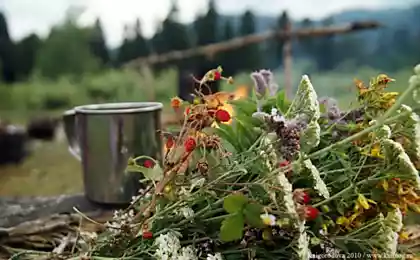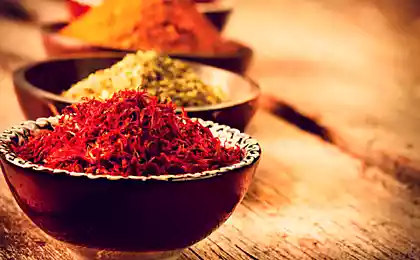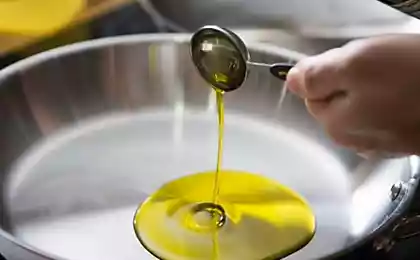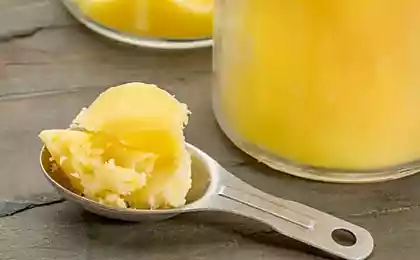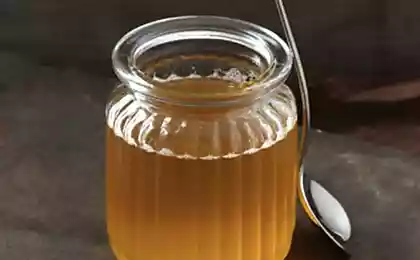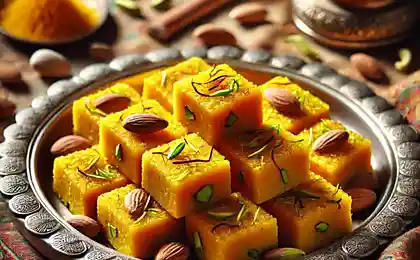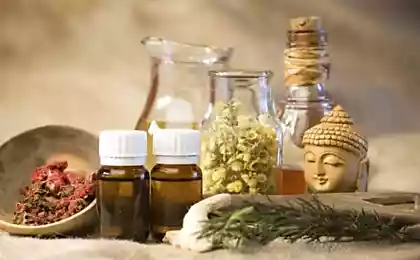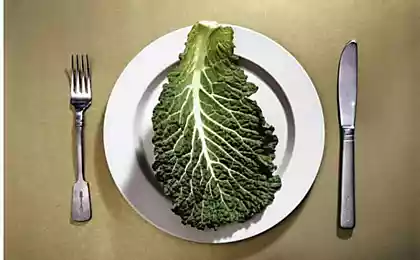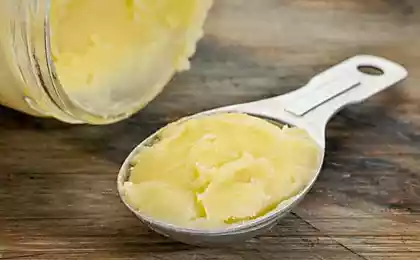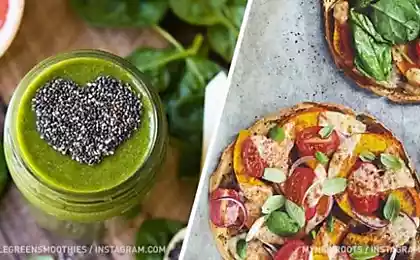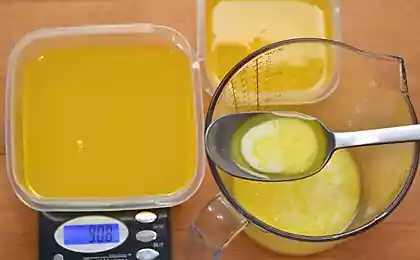676
Ghee —blessed food
Forty four million eight hundred fifty eight thousand nineteen
Use gheePure ghee protects our bodies from harmful free radicals, is an ideal source of fatty acids.
Ghee is a Sanskrit word that refers to melted butter. Ghee is an ordinary butter without the lactose and other milk residues (which is why this oil is suitable for people who are lactose-intolerant). Ghee is prepared by boiling butter and removing milk residues dry.
Despite the fact that ghee is a saturated oil, in its molecular structure, it differs from other animal fats. It consists of fatty acids with a short chemical chain (easily digested), in contrast to fatty acids with long chemical chain (which is difficult to digest and causes cancer and blood clots).
Ghee contains fatty acids, 8 percent less saturated in comparison with other edible fats, which makes it easier to digest. Protein casein, increase the level of cholesterol in the blood, is removed from the butter ghee while it is cooking. Ghee also contains antioxidant vitamin E and is the only edible oil that contains vitamin A. Antioxidants help to prevent oxidation of lipids, causing atherosclerosis and DNA damage in cells. According to one study, ghee does not contain oxidation products of cholesterol.
Ghee contains 4 to 5% linoleic acid, essential fatty acids, which ensures the growth and development of tissues and organs of the body. "Essential fatty acid" means that the body itself cannot produce this acid and for the proper functioning it must obtain it from food.
Ghee stays fresh for three to four months, even at room temperature, it becomes rancid and not oxidized.
The ghee does not burn when frying. This is a very big advantage as vegetable oil and butter in combustion be carcinogenic, create free radicals and are difficult to digest.
Ghee is ideal for Hiking.
The preparation of ghee (ghee)The essence of cooking medicated oil to remove all impurities and water. When peretaplivanii not burning the oil itself, and the residue, which falls to the bottom of the pan. So, to avoid overcooking, take the pot with a thick bottom and flush on very low heat. Well suited Zepter or something like that. But physical therapy is not at all. In this case, the fine will rescue the way I met one of the Ayurvedic forums.
It is necessary to prepare three perfectly clean pan, preferably enameled. Aluminum cookware, in principle, not suitable for any Ayurvedic action in the kitchen.
So, You buy butter at the nearest grocery store. The oil should be without any additives and unsalted. If possible, the best option is a rustic oil. But You should be familiar with the owner of the cow, from which the oil is derived and believe that the cow is healthy, and the woman observes cleanliness while milking. As the requirements for starting materials is very high, You need to understand that no import is perfect. The raw material must be only local. If Your location oil does not produce, then look where it brought. Good oil cook dairy plants in Siberia.
You bought butter cut into small pieces and put in the first pot. The pan put on low heat and carefully watch the process. As the melting is formed on top of the white foam cap that You constantly removed. (The foam can then be used to add to cereal or other foods). Oil at the initial stage, muddy.
Gradually the oil will become transparent and You will see that at the bottom of the accumulated liquid residue — it contains water and impurities. As perekopki water boils, and the residue compacted. Here there is a danger that it will burn slightly. In this moment You remove the pan from the heat and on the burner, put the next pan. From the first pan pour oil in the second a thin stream so that sediment remained in the first pot.
Continue to heat the oil in the second pan. In the second pot You will have to have much less foam and sludge, but still they will. Continue to remove the foam and watch for sediment. Oil is heated in the second pot, usually short, specific time depends on the quantity of the product. Here you must learn to feel that, and the sediment starts to burn. With some experience it will come.
So when You feel that burning sludge will begin soon, last time remove the foam and remove the pan from the heat. Put on the third burner the pan and again pour oil in a thin stream from the second pan to the third so that the sediment remained in the second pot.
If You did everything correctly in the previous steps, then in the third pot, You won't have any foam or sediment. The third pot is likely to check the quality of the product than for its further purification. So, to make sure the oil is completely clean, it is possible for a short time to turn the fire on full power. Clean oil over high heat boils and no foam formation and sludge. Include a strong fire for 10 — 15 seconds, no more. If you overdo, you risk turning Your oil into soap. This risk is especially great if You are not well washed with soda pot, which cleaned it from the scale. Yes, and the scum on the sides of the pan can give the saponification of the oil at high temperature.
Therefore, it is necessary to remember about two extremes that should not be allowed in this process: insufficient heating of the oil will leave the water in it, and the oil can deteriorate; and is fraught with overheating scorching and the saponification of the oil.
Oil which You receive, is amber-yellow color, pleasant smell and taste. Remember these signs. They will be for You a criterion of the quality of oil cooked on the fire.
Summary for cooking:
1. Crockery. Ideally — spherical shape of the bottom (bulge outwards). The metal is thick, it is best not enameled (inside) cast iron or duralumin cauldron.
2. Fire. Constant, the smallest (but not to the point of absurdity). The smallest on a gas stove with divider — enough. When the butter has melted, it should not be boiling and bubbling heavily. The surface of her needs just a little "worry", in the thickness of the product must be the enigmatic rotation of the white particles (many of them).
3. Raw. Butter. Best rustic sold by weight (see below) or from Finnish Valio, for example, or Anchor. Look at the label. Ingredients — butter, not margarine and mysterious vegetable fats...
4. Process. Patience. Again patience. The process is long. Not to stand over him. The first wave of foam to remove and forget. From time to time to stir. Less than 1 kg. Yield about 700 g of kg. the bigger the mass, the more time. Nutty smell not strong, but subtle, although the habit can not catch. Then the reference — transparency. Ready guy becomes absolutely transparent, white weight ceases to swim part of it settles in a dense pile at the bottom, some remains of a swim top. It is a signal that the process has got to stop. To prevent on the bottom shades of brown, acrid smoke and an unpleasant smell.
What should be done correctly GI.
1.In a day when 20 to harden.
2.To be homogeneous.
3.Should not split into factions.
4. To be beautiful (yellow like the sun)
5. When reheating (cooking on it something) not to burn, not to smoke, not foam.
6. Well smudge (especially on freshly baked bread)
7.Cause a desire to eat only to them.
GI from the village of loose oilPreparation of ghee from the village of loose oil — personal experience:
Just bought a pound on trial, were heated it quickly (about an hour or slightly less — only half a kilo), even the foam has never been removed, when it became uniformly transparent yellow, was removed from the fire and later carefully poured into the jar. To the great astonishment, the oil froze completely after half an hour after cooled. At room temperature, and the day was hot — 30 degrees. Produce a uniform, with a wonderful aroma and taste, not a hint of graininess. It is dense and remains, even in 30 plus degree heat. Of the oil or similar in Moscow I couldn't do it and of the most expensive varieties.
So those who have the opportunity to buy simple bulk oil — I recommend to try to prepare ghee from it. I know that in Moscow in the markets sold by such oil. Not know always whether it is of such quality, but worth a try, because it is the perfect ghee does not work when perekopke oil from packs.
GI (ghee) in AyurvedaOil GI (Ghee) in Ayurveda is one of the most sattvic foods. Sattvic means blissful, Divine. Here are some characteristic oil GI (Ghee) give Vasant Lad and David Frawley in his book "Herbs and spices":
GI (Ghee) increases Ojas — the subtle essence of all tissues. It reinforces all kinds of Agni, increase energy, digestive processes and the action of enzymes in the organism without initiating pitt. It applies, in particular, jatharagni (digestive fire of the small intestine) and bhutagni (the fiery force of the liver, controlling the transformation of food). It does not clog the liver as other oils and fats, by contrast, gives her strength.
Oil GI (Ghee) feeds Majah-that (bone marrow and nervous tissue), as well as the brain. Increasing Ojas, it has a positive effect on all the subtle tissues of the body, including shukra-dhatu (reproductive tissue). By Ojas it nourishes the Tejas — fire of the mind — and thus enhances medhani — fire intelligence and perception. Having such properties, it is a wonderful rejuvenating, tonic (rasayanas) for mind, brain, and nervous system. It is good for Wool and Pitta.
Oil GI (Ghee) is very often used all the bitter Ayurvedic herbs, calamus, Amalaki, ashwagandha, brahmi, eclipta Alba, gokshura, pomegranate, Jasmine, manjishtha, licorice, Triphala, garlic, shatavari, and many others.
The benefits of dairy productsProducts like cheese, butter, yogurt, fermented baked milk, buttermilk — all considered healthy, nutritious, those in the mode of goodness and auspicious. In Ayurveda dairy products are even used in the treatment of such diseases as AIDS, cancer and so on. It is believed that ghee and butter — raise man, promote enthusiasm (people without enthusiasm are not able to engage in spiritual practices), nourish the mind, increase the discrimination ability of the person.
With proper consumption of dairy products — a person is able to eat and grow in goodness.
The Vedas claim that one and only one cow products it is enough for the existence of life. And if you pay attention to how they lived, the cowherd and the village where Krishna lived and what they did — you will note that in fact — they lived and ate only dairy products.
For any yoga — it is recommended the use of milk (once again I remind about correct use, i.e. taking into account the time of consumption). For people, practicing the pranayama-yoga it is recommended to consume dairy products in the first place — because they cleanse and amplifies prana.published
P. S. And remember, only by changing their consumption — together we change the world! ©
Source: www.ghee.ru/maslo/interesting/2-process.html
Use gheePure ghee protects our bodies from harmful free radicals, is an ideal source of fatty acids.
Ghee is a Sanskrit word that refers to melted butter. Ghee is an ordinary butter without the lactose and other milk residues (which is why this oil is suitable for people who are lactose-intolerant). Ghee is prepared by boiling butter and removing milk residues dry.
Despite the fact that ghee is a saturated oil, in its molecular structure, it differs from other animal fats. It consists of fatty acids with a short chemical chain (easily digested), in contrast to fatty acids with long chemical chain (which is difficult to digest and causes cancer and blood clots).
Ghee contains fatty acids, 8 percent less saturated in comparison with other edible fats, which makes it easier to digest. Protein casein, increase the level of cholesterol in the blood, is removed from the butter ghee while it is cooking. Ghee also contains antioxidant vitamin E and is the only edible oil that contains vitamin A. Antioxidants help to prevent oxidation of lipids, causing atherosclerosis and DNA damage in cells. According to one study, ghee does not contain oxidation products of cholesterol.
Ghee contains 4 to 5% linoleic acid, essential fatty acids, which ensures the growth and development of tissues and organs of the body. "Essential fatty acid" means that the body itself cannot produce this acid and for the proper functioning it must obtain it from food.
Ghee stays fresh for three to four months, even at room temperature, it becomes rancid and not oxidized.
The ghee does not burn when frying. This is a very big advantage as vegetable oil and butter in combustion be carcinogenic, create free radicals and are difficult to digest.
Ghee is ideal for Hiking.
The preparation of ghee (ghee)The essence of cooking medicated oil to remove all impurities and water. When peretaplivanii not burning the oil itself, and the residue, which falls to the bottom of the pan. So, to avoid overcooking, take the pot with a thick bottom and flush on very low heat. Well suited Zepter or something like that. But physical therapy is not at all. In this case, the fine will rescue the way I met one of the Ayurvedic forums.
It is necessary to prepare three perfectly clean pan, preferably enameled. Aluminum cookware, in principle, not suitable for any Ayurvedic action in the kitchen.
So, You buy butter at the nearest grocery store. The oil should be without any additives and unsalted. If possible, the best option is a rustic oil. But You should be familiar with the owner of the cow, from which the oil is derived and believe that the cow is healthy, and the woman observes cleanliness while milking. As the requirements for starting materials is very high, You need to understand that no import is perfect. The raw material must be only local. If Your location oil does not produce, then look where it brought. Good oil cook dairy plants in Siberia.
You bought butter cut into small pieces and put in the first pot. The pan put on low heat and carefully watch the process. As the melting is formed on top of the white foam cap that You constantly removed. (The foam can then be used to add to cereal or other foods). Oil at the initial stage, muddy.
Gradually the oil will become transparent and You will see that at the bottom of the accumulated liquid residue — it contains water and impurities. As perekopki water boils, and the residue compacted. Here there is a danger that it will burn slightly. In this moment You remove the pan from the heat and on the burner, put the next pan. From the first pan pour oil in the second a thin stream so that sediment remained in the first pot.
Continue to heat the oil in the second pan. In the second pot You will have to have much less foam and sludge, but still they will. Continue to remove the foam and watch for sediment. Oil is heated in the second pot, usually short, specific time depends on the quantity of the product. Here you must learn to feel that, and the sediment starts to burn. With some experience it will come.
So when You feel that burning sludge will begin soon, last time remove the foam and remove the pan from the heat. Put on the third burner the pan and again pour oil in a thin stream from the second pan to the third so that the sediment remained in the second pot.
If You did everything correctly in the previous steps, then in the third pot, You won't have any foam or sediment. The third pot is likely to check the quality of the product than for its further purification. So, to make sure the oil is completely clean, it is possible for a short time to turn the fire on full power. Clean oil over high heat boils and no foam formation and sludge. Include a strong fire for 10 — 15 seconds, no more. If you overdo, you risk turning Your oil into soap. This risk is especially great if You are not well washed with soda pot, which cleaned it from the scale. Yes, and the scum on the sides of the pan can give the saponification of the oil at high temperature.
Therefore, it is necessary to remember about two extremes that should not be allowed in this process: insufficient heating of the oil will leave the water in it, and the oil can deteriorate; and is fraught with overheating scorching and the saponification of the oil.
Oil which You receive, is amber-yellow color, pleasant smell and taste. Remember these signs. They will be for You a criterion of the quality of oil cooked on the fire.
Summary for cooking:
1. Crockery. Ideally — spherical shape of the bottom (bulge outwards). The metal is thick, it is best not enameled (inside) cast iron or duralumin cauldron.
2. Fire. Constant, the smallest (but not to the point of absurdity). The smallest on a gas stove with divider — enough. When the butter has melted, it should not be boiling and bubbling heavily. The surface of her needs just a little "worry", in the thickness of the product must be the enigmatic rotation of the white particles (many of them).
3. Raw. Butter. Best rustic sold by weight (see below) or from Finnish Valio, for example, or Anchor. Look at the label. Ingredients — butter, not margarine and mysterious vegetable fats...
4. Process. Patience. Again patience. The process is long. Not to stand over him. The first wave of foam to remove and forget. From time to time to stir. Less than 1 kg. Yield about 700 g of kg. the bigger the mass, the more time. Nutty smell not strong, but subtle, although the habit can not catch. Then the reference — transparency. Ready guy becomes absolutely transparent, white weight ceases to swim part of it settles in a dense pile at the bottom, some remains of a swim top. It is a signal that the process has got to stop. To prevent on the bottom shades of brown, acrid smoke and an unpleasant smell.
What should be done correctly GI.
1.In a day when 20 to harden.
2.To be homogeneous.
3.Should not split into factions.
4. To be beautiful (yellow like the sun)
5. When reheating (cooking on it something) not to burn, not to smoke, not foam.
6. Well smudge (especially on freshly baked bread)
7.Cause a desire to eat only to them.
GI from the village of loose oilPreparation of ghee from the village of loose oil — personal experience:
Just bought a pound on trial, were heated it quickly (about an hour or slightly less — only half a kilo), even the foam has never been removed, when it became uniformly transparent yellow, was removed from the fire and later carefully poured into the jar. To the great astonishment, the oil froze completely after half an hour after cooled. At room temperature, and the day was hot — 30 degrees. Produce a uniform, with a wonderful aroma and taste, not a hint of graininess. It is dense and remains, even in 30 plus degree heat. Of the oil or similar in Moscow I couldn't do it and of the most expensive varieties.
So those who have the opportunity to buy simple bulk oil — I recommend to try to prepare ghee from it. I know that in Moscow in the markets sold by such oil. Not know always whether it is of such quality, but worth a try, because it is the perfect ghee does not work when perekopke oil from packs.
GI (ghee) in AyurvedaOil GI (Ghee) in Ayurveda is one of the most sattvic foods. Sattvic means blissful, Divine. Here are some characteristic oil GI (Ghee) give Vasant Lad and David Frawley in his book "Herbs and spices":
GI (Ghee) increases Ojas — the subtle essence of all tissues. It reinforces all kinds of Agni, increase energy, digestive processes and the action of enzymes in the organism without initiating pitt. It applies, in particular, jatharagni (digestive fire of the small intestine) and bhutagni (the fiery force of the liver, controlling the transformation of food). It does not clog the liver as other oils and fats, by contrast, gives her strength.
Oil GI (Ghee) feeds Majah-that (bone marrow and nervous tissue), as well as the brain. Increasing Ojas, it has a positive effect on all the subtle tissues of the body, including shukra-dhatu (reproductive tissue). By Ojas it nourishes the Tejas — fire of the mind — and thus enhances medhani — fire intelligence and perception. Having such properties, it is a wonderful rejuvenating, tonic (rasayanas) for mind, brain, and nervous system. It is good for Wool and Pitta.
Oil GI (Ghee) is very often used all the bitter Ayurvedic herbs, calamus, Amalaki, ashwagandha, brahmi, eclipta Alba, gokshura, pomegranate, Jasmine, manjishtha, licorice, Triphala, garlic, shatavari, and many others.
The benefits of dairy productsProducts like cheese, butter, yogurt, fermented baked milk, buttermilk — all considered healthy, nutritious, those in the mode of goodness and auspicious. In Ayurveda dairy products are even used in the treatment of such diseases as AIDS, cancer and so on. It is believed that ghee and butter — raise man, promote enthusiasm (people without enthusiasm are not able to engage in spiritual practices), nourish the mind, increase the discrimination ability of the person.
With proper consumption of dairy products — a person is able to eat and grow in goodness.
The Vedas claim that one and only one cow products it is enough for the existence of life. And if you pay attention to how they lived, the cowherd and the village where Krishna lived and what they did — you will note that in fact — they lived and ate only dairy products.
For any yoga — it is recommended the use of milk (once again I remind about correct use, i.e. taking into account the time of consumption). For people, practicing the pranayama-yoga it is recommended to consume dairy products in the first place — because they cleanse and amplifies prana.published
P. S. And remember, only by changing their consumption — together we change the world! ©
Source: www.ghee.ru/maslo/interesting/2-process.html
Print simple bamboo wind turbine for charging your smartphone
Why almost all of our "pillars" of success is an illusion
